Ijraset Journal For Research in Applied Science and Engineering Technology
- Home / Ijraset
- On This Page
- Abstract
- Introduction
- Conclusion
- References
- Copyright
Comparative Study of Dye Degradation by Using Green Synthesized ZnO Nanoparticle and Bacillus
Authors: Geetha G, Lincy. M
DOI Link: https://doi.org/10.22214/ijraset.2022.42535
Certificate: View Certificate
Abstract
Comparative study of methylene blue degradation by using green synthesized zinc oxide nanoparticle and microorganism. Zinc oxide nanoparticle are synthesized by using Camellia sinensis plant extract. Comparative study shows that zinc oxide nanoparticle is more effective in degradation of methylene blue dye than microorganism. ZnO nanoparticle are capable to degrade methylene blue in brief time due to its extract capped zinc oxide nanoparticle. Using Bacillus species degradation of dye increase with increasing time.
Introduction
I. INTRODUCTION
Nanotechnology is science engineering and technology conducted at Nanoscale which is about 1 to 100 nm. The idea and concept behind nanoscience and nanotechnology started with talk entitled “The plenty of room at the bottum” By Richard fayman. The green synthesis of nanoparticle exhibit unique properties at nanoscale. Zinc oxide nanoparticle are synthesized by using green tea leaf plant extract Camellia sinensis or green tea .Further produced ZnO were also characterized by UV visible, FTIR, and XRD.Zinc oxide nanoparticle belongs to class of metal oxides, which is characterized by photocatlytic and photo oxidizing activity Dyes are structural complex material which enter in the environment due to Various textile industry processes like dyeing and cloth completion process. Methylene blue is the one of the most important cationic dye which is now used in textile industry Nanoparticle are used as a photo catlyst in the presence of uv to remove MB Dye. The focus on present work is to apply the accurate principles of green chemistry for the synthesis of zinc oxide nanoparticle by using green tea leaf. This work ZnO nanoparticle were prepared by biological method that means green synthesis. In this ZnO nanoparticle as precursors for the degradation of dyes. Comparison of dye degradation by using microorganism and nanoparticle.
Synthesize zinc oxide nanoparticle via biological method. To explore the degradation of dye using zinc oxide nanoparticle via photocatlytic reaction. Comparison of dye degradation by using nanoparticle and microorganism. Test the dye degradation in increasing time period.
II. MATERIALS AND METHODS COLLECTION OF PLANT MATERIAL
Plant materials was collected from local areas in Palakkad, Kerala. Plant material was cleaned with distilled water and dry at room temperature. The dried plant materials were crushed in to powder form.
A. Isolation of Organisms from soil. Sample Collection
Soil sample was collected from the nearby my native place .The soil sample for isolation of microbes were obtained from the 5 to 10 cm layer below the soil surface.
B. Isolation Method
Serial dilution of soil sample;
- 10 g of soil sample was taken and add to 95 ml of distilled water. Shake the suspension well.
- Before the soil settlers, remove 1 ml of the suspension with a sterile pipette and transfer it to 9 ml distilled water.
- Repeating the dilution step for 7 tubes containing 9 ml distilled water. This result in serial dilution 1st tube to 7th tube.
The diluted suspension was transferred into nutrient agar plates. The major bacteria present in the soil sample are selected and characterized by growing them on some selective media. The organisms was isolated on Mannitol salt agar media, MacConkey agar media and nutrient agar media. Then all the culture were maintained on the respective slant.
C. Isolation on Selective Media
The identified colonies were then inoculated on to selective media such as Nutrient agar, Mannitol salt agar to study the colony characteristics.
Nutrient agar
Peptone : 0.5
Beef extract : 0.3 g
Sodium chloride : 0.5 g
Agar. : 2.0g
Distilled water : 100 ml
Mac Conkey agar (pH 7.1)
|
Peptone. |
: 1.7 g |
|
Protease peptone. |
: 0.3 g |
|
Lactose. |
: 1.0 g |
|
Bile salt mixture |
: 0.15 g |
|
Sodium chloride. |
: 0.5 g |
|
Distilled water. |
: 100 ml |
One hundred ml of pseudomonas agar was prepared and sterilized at 121ºc for 15 minutes at 15 lbs pressure .Then it poured in to Petri plates and allowed to solidify. Then the organism were inoculated and incubate the Petri plates at 37ºc for 24 hours and observed the growth was observed.
D. Collection of Plant Material
Plant material was collected from local area in Palakkad Kerala. Plant material was cleaned with distilled water and dry at room temperature. The dried plant material was crushed into powder form Camellia sinensis: green tea leaf Bacterial isolates
To isolate bacteria from soil. The Bacillus Species are isolated from different soil samples.
Isolation of microorganism Preparation of inoculum. Isolation on selective media.
Morphology and biochemical characterization of the isolates.
E. Preparations of Plant Extract.
The 10 g of dried leaves were heated in 100 ml deionised water with 80°c with the continuous stirring for 2 hours.
- Then cooled at room temperature and filtered by using what’s man filter paper no 40.
- Centrifugation at 4000 rpm for 10 min and coloured pellets are settled at the bottom of the tube.
F. Green Synthesis of Zinc Oxide Nanoparticle.
Zinc nitrate solution of 50 ml was added to 5 ml of green tea leaf extract. The solution was stirred on magnetic stirrer at 120°c. The colour was observed from light brown to blackish brown.
The resultant solution was centrifuged for the minutes speed of50,000 rpm After discarding suspended zinc oxide nanoparticle were dried in watch glass Yellow coloured particle were collected for characterization. Characterization techniques of green synthesized zinc oxide NP
- XRD
- UV VISIBLE SPECTRA
- FTIR
G. Dye
Methylene blue organic dye with greenish blue colour. Methylene blue does not undergo photo degradation without a photo catalyst. It is photo stable and would only degrade by photocatlysis.
III. RESULT AND DISCUSSION
A. Microscopic Analysis

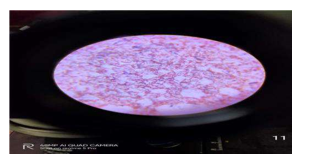
B. Isolation of Microorganism on Selective Media
After inoculation on to selective media organism was identified based on their colony morphology, the organism identified were Bacillus. The result have been tabulated in
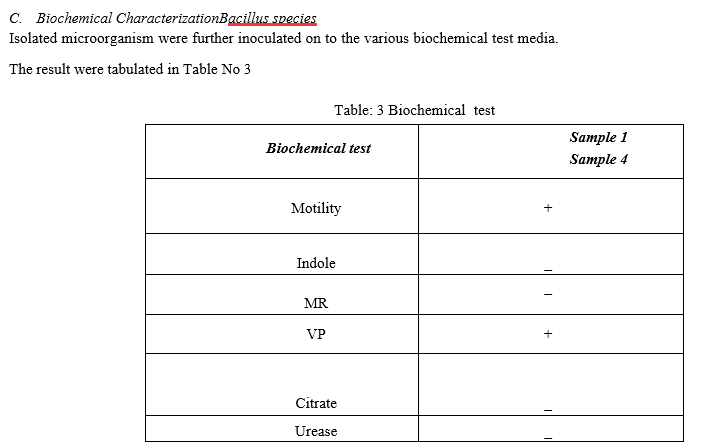
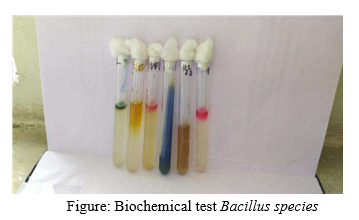
F. Production of Zinc Oxide Nanoparticle
The production of zinc oxide nanoparticle by using dried green tea leaf. The pale yellow white colour of the zinc oxide nanoparticle arise due to capping action of biomolecule of green tea leaf extract on the surface of nanoparticle. When the mixture of salt zinc nitrate and green tea leaf was add and heat the colour change was appear .colour change indicate formation of zinc oxide nanoparticle
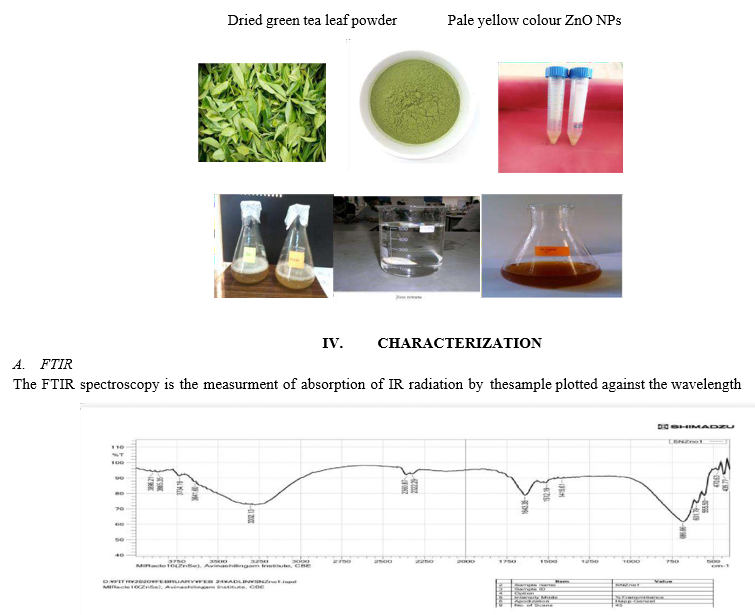
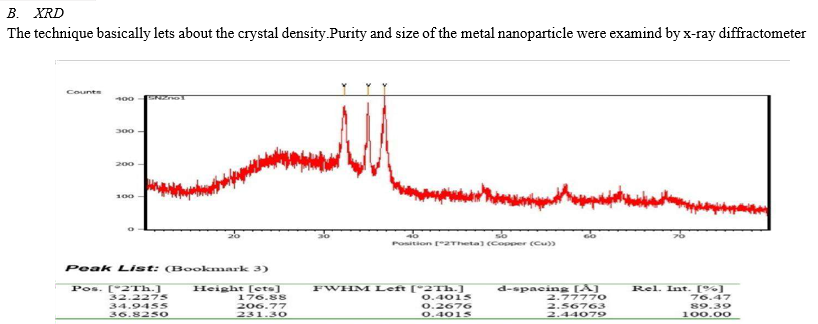
C. Methylene Blue Dye
Methylene blue is an organic dye with greenish blue color that is found in family of dyes known as phenothazine.it is used in the leather, paper, and textile industries for their product. Methylene blue does not undergo degradation by hydrolysis as well as photo degradation without a photo catalyst. The dye is photo stable and would only degrade by photo catalysis.
D. Decolourization of Dye
Decolourization of dye by using microorganism. Effect of incubation time on decolourization of methylene blue. The course of decolorization of methylene blue dye bt bacillus species under the optimum conditions the persentage of decolourization its tabulated below. The result shows that decolourization rate of methylene blue by bacillus species increase with increasing time period
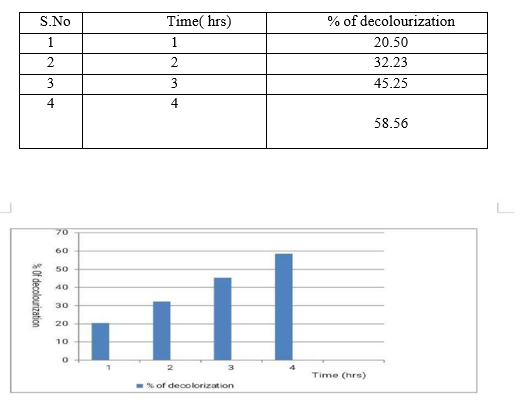
E. Decolourization of Methylene blue by using ZnO Nanoparticle
Photo degradation of dye by using zinc oxide nanoparticle. The photo degradation of methylene blue observed at different time period. The absorbance OD MeB was decreased with increasing time period in presence of zinc oxide nanoparticle and uv light – visible spectra data of methylene blue treated with the photo degradation reaction in presence of zinc oxide nanoparticle.
|
Reaction condition |
Peck (nm) |
Absorbance with ZnO |
|
Starting solution |
663.73 |
0.5493 |
|
After 1 hr kept in sunlight |
663.73 |
0.4532 |
|
After 2 hr kept in sunlight |
663.73 |
0.3823 |
|
After 3hr kept in sunlight |
663.73 |
0.2365 |
|
After 4 hr kept in sunlight |
663.73 |
0.0740 |
Conclusion
Dye degradation process become main cost effective processes in now a days. Degradation of dye is very effective by using green synthesized nanoparticle. The biosynthesis of nanoparticle is very cost effective and ecofriendly using Bacillus species the degradation rate after 4 hour incubation is 58.69. In the case of ZnO nanoparticles degradation rate of starting solution is 0.5493 and after 4 hour incubation the rate become decreased. Combative study shows that zinc oxide nanoparticle e is more effective in degradation of. Methylene blue dye than microorganism.
References
[1] Agarwal,H.,Kumar,S.V.,&RajeshKumar,S.(2017).A review on green synthesis o f zinc oxide nanoparticles–Aneco•friendlyapproach.Resource•Efficient technologies,3,406413.doi:10.1016/jreffit.2017.03.002Awwad,A.M.,Albiss,B.,&Ahm ad,A.L (2014).Greensynthesis,characterization and optical properties of zinc oxide Nano sheet s using Oleaeuropea leaf extract.AdvancedMaterialsLetters 5,520–524. doi:10.5185/amlett.2014.5575 [2] Boran,H.,Ciftci,C.,Er,A.,Kose,O.,Kurtoglu,I.Z.,&Kay?s, S.(2015).Evaluation of antibacterial activity of green tea(CamelliasinensisL.)seed s against some fish pathogens in rainbow trout(Oncorhynchusmykiss,Walbaum).Turkish Journal of Fisheries and Aquatic Sciences15,49– 57.doi:10.4194/1303•2712•v15_1_0 [3] Datta,A.,Patra,C.,Bharadwaj,H.,Kaur,S.,Dimri,N.,&Khajuria,R. (2017).Green synthesis of zinc oxide nanoparticles using partheniumhysterophorus leaf extract and evaluation of the irantibacterialproperties.JournalofBiotechnologyandBiomaterials,7,271– 275.doi:10.4172/2155952X.1000271. [4] Dhanemozhi,A.C.,Rajeswari,V.,&Sathyajothi,S.(2017).Green synthesis of zinc oxide nanoparticle using green tea leaf extract forsupercapacitor application. MaterialsToday: Proceedings, 4, 660–667. doi:10.1016/j.matpr.2017.01.070 [5] Dura´nN,MarcatoPD,DeSouzaGIH,AlvesOL,Espositoe (2007)Antibacterial effector silver nanoparticles produced by fungal process on textile fabrics and the effluent treatment.JbiomedNanotechnol3:203–208 [6] FeiB,DengZ,XinJH,ZhangY,PangG(2006)Room temperature synthesis of rutilenanorods and their applications oncloth.Nanotechnology17:1927–1931 [7] GambichlerT,AvermaeteA,BaderA,AltmeyerP,HoffmannK(2001)Ultraviolet protection by summer textiles. Ultraviolet transmission measurements verified by deter•mination of the minimal erythema dose with solarsimulatedradiation.BrJDermatol144:484–489. [8] GuoL, YangS, YangC, YuP, WangJ,GeW,WongGKL(2000)Synthesis and characterization of poly (vinylpyrr• olidone)• modified zinc oxide nanoparticles. ChemMater12:2268–2274 [9] JenkinsR, SnyderRL(1996)Introduction to Xray powder diffractometry. JohnWiley&Sons, NewYork. [10] Hoffman, M.R., Martin, S.T., Choi, w., Bahnemann, D.W., 1995 Environmental applications of semiconductor photo catalysis. Chem. Rev. 95, 69•96. [11] Hu, j,s ., Ren, L.L.,Guo,Y.G.,Liang,H.P., Cao,A.M.,Wan,J.J., et al., 2005 . Mass production and high photocatlytic activity of ZnS nonporous nanoparticle. Angew. Chem.int.Ed.44,1269•1273. [12] Ingle, A., Grade, A., Pierrat, s.,et al .2008.mycosynthesis of silver nanoparticles using the fungus Fermium acuminatum and its activity against some human pathogenic bacteria ,Curr Nanosci 4; 141•144. [13] Iravani,S.2011. Green synthesis of metal nanoparticle using plants. Green chem., 13; 2638•2650. [14] KumarSSR(2017)Green synthesis of nanoparticle using plant extract and their effect on Rumen fermentation. Kou Y , Yang j, Li B, Fu S., Mater Res bull,2005,63,105. [15] Nagajyothi P.C., S.V prabhakar .,K.C Devarayapalli ., green synthesis : photocatlytic degradation of textile dye using metal and metal oxide nanoparticle latest trend and advanced.246•432. [16] Malapermal,v.,Mbatha, j,n., gengan, R,M., And Anand, k.(2015). Biosynthesis of biometalic Ag•Au nanoparticle ocimum basilicum(L) with antidiabetic and antimicrobial properties.1050•1057. [17] Mabel Joshaline. C, Subathra M., shyamala M. And S. Padmavath. A novel textile dye decolourising bacteria• A report. International journal of scientific and engineering researh, 2013;4(12);1483 [18] Rauf MA, Bukallah SB, Hamadi A, Sulaiman A, Hammadi F (2007) The effect of operational parameters on the photo induced decolourization of dye using hybrid catalyst 129;167•172. [19] Shanti M, Kuzhalosai V (2012) photocatlytic degradation of an azo dye ,acid red 27,in aqueous solution using nano ZnO Indian j chem 51A;428•434. [20] Tayler AA, El•Tras WF, Moussa S, El•Baz AF, Mahrous H, salem MF, Brimer L (2011)antibacterial action of zinc oxide nanoparticle against food born pathogens.211218.
Copyright
Copyright © 2022 Geetha G, Lincy. M. This is an open access article distributed under the Creative Commons Attribution License, which permits unrestricted use, distribution, and reproduction in any medium, provided the original work is properly cited.

Download Paper
Paper Id : IJRASET42535
Publish Date : 2022-05-11
ISSN : 2321-9653
Publisher Name : IJRASET
DOI Link : Click Here
 Submit Paper Online
Submit Paper Online

